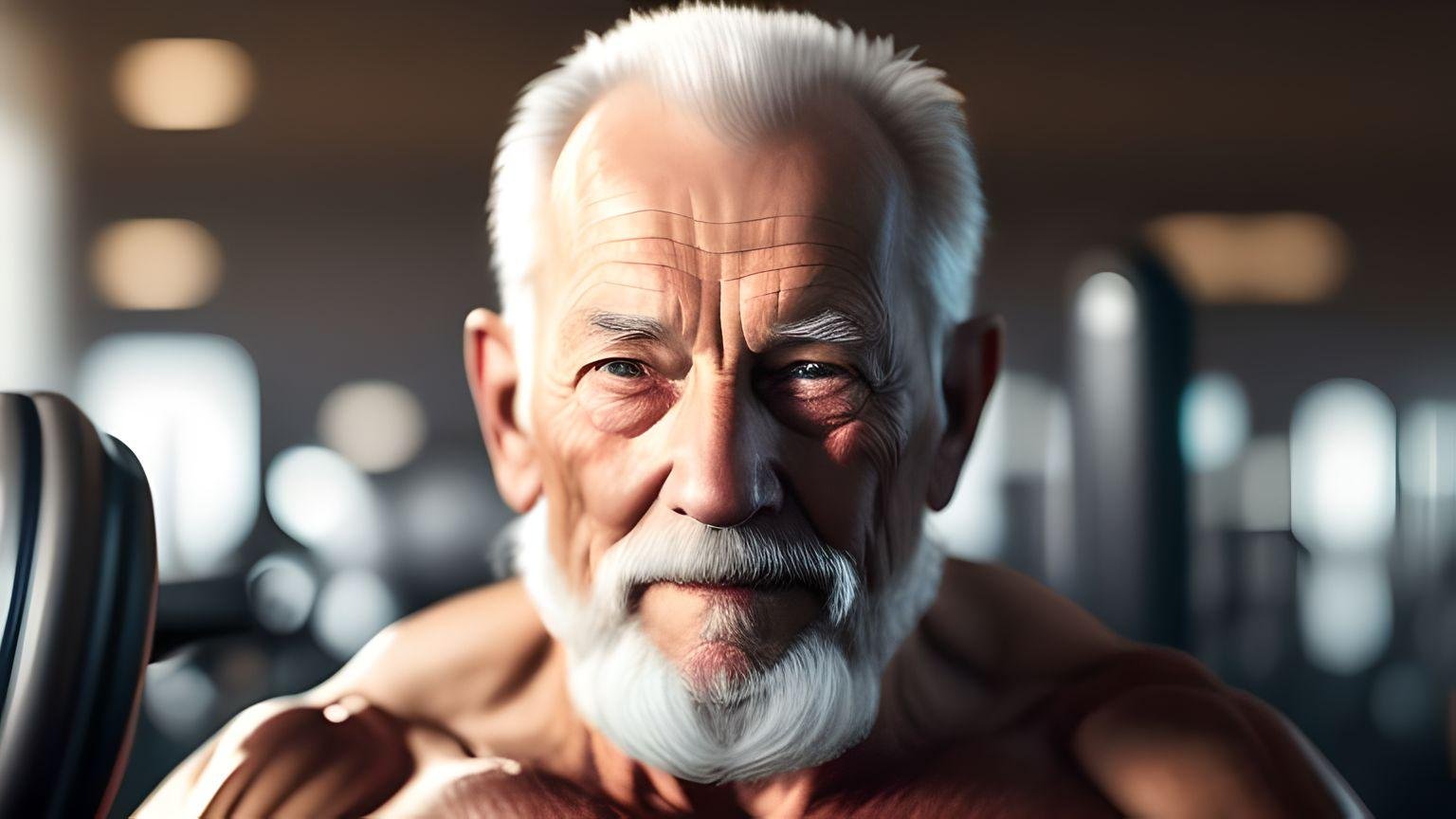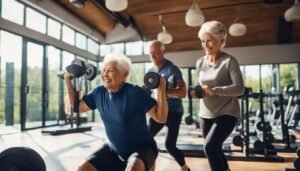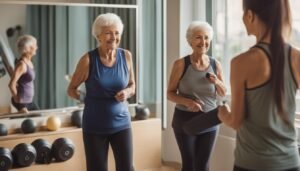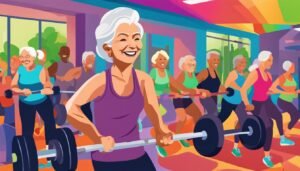Fitness is a lifelong pursuit that should be accessible to everyone, regardless of age. Ageism in fitness can be a barrier that prevents many from fully enjoying the benefits of physical activity. That’s why we believe it’s important to address the specific needs and preferences of those over 40 when it comes to exercise routines and fitness programs.
With this in mind, we have curated a collection of specialized workouts that cater to aging adults. These programs are designed to help you stay fit, strong, and healthy as you navigate the challenges that come with getting older.
Key Takeaways:
- Specialized workouts are essential for adults over 40 to meet their fitness goals.
- Fitness programs for aging adults ensure that your exercise routines are tailored to your needs.
- Exercise routines for seniors focus on strength, flexibility, and overall well-being.
- Engaging in age-appropriate fitness activities can help prevent injuries and promote longevity.
- It’s never too late to start or continue your fitness journey, no matter your age.
Sign 1: Presumptuous Stereotypes
Ageism in fitness can manifest in the form of presumptuous stereotypes that people hold based on someone’s age. These stereotypes often lead others to make assumptions about an individual’s fitness abilities and interests without truly understanding their capabilities or desires. For those over 40, it’s not uncommon to encounter people who believe they can’t keep up with younger individuals or assume they lack interest in challenging workouts.
By perpetuating these stereotypes, ageism in fitness undermines the potential and motivation of older adults to engage in physical activity. It’s important to challenge and debunk these assumptions, as individuals over 40 can have a wide range of fitness abilities that are often overlooked.
Quote: “Don’t judge a book by its cover. Age is just a number, and it doesn’t define what someone is capable of achieving in their fitness journey.” – Fitness enthusiast, Jane Smith
Sign 1: Presumptuous Stereotypes
Presumptuous stereotypes can be detrimental to older adults’ fitness experiences and goals. By assuming limitations based on age, individuals may miss out on opportunities for growth, challenge, and overall satisfaction in their fitness routines. It is crucial to foster an inclusive environment that values and supports fitness abilities, regardless of age.
| Stereotype | Reality |
|---|---|
| Older adults can’t keep up with younger individuals | Age does not determine fitness level. Many older adults can perform at high levels of intensity. |
| Older adults are not interested in challenging workouts | Older adults can be just as motivated and interested in challenging workouts as younger individuals. |
Sign 2: Limited Program Options
When it comes to maintaining fitness and well-being, finding age-appropriate fitness programs is crucial. Unfortunately, one sign of ageism in the fitness industry is the limited options available for those over 40. Many gyms and fitness facilities tend to focus on classes and workout routines that cater to younger individuals, neglecting the specific needs and preferences of older adults.
Gym classes that are designed primarily for younger individuals may not take into account the potential limitations that come with age. These classes may be too intense or demanding for older adults, leading to discomfort or even injury. Additionally, the exercises and routines may not align with the goals and abilities of those over 40.
To address this sign of ageism, it is important for fitness facilities to offer a diverse range of age-appropriate fitness programs. This could include classes specifically tailored for older adults, such as low-impact workouts, strength training with lighter weights, or flexibility-focused sessions. By providing a variety of program options, gyms can create a more inclusive and welcoming environment for individuals of all age groups.
Table: Example Age-Appropriate Fitness Program Options
| Program | Description |
|---|---|
| Senior Strength Training | A weightlifting program that focuses on building and maintaining muscle mass in older adults. Modified exercises and lighter weights are used to ensure safety and effectiveness. |
| Gentle Yoga | A yoga class that incorporates gentle stretches and poses to improve flexibility and balance without putting excessive strain on the joints. |
| Aqua Aerobics | An aerobic exercise class conducted in a pool, offering the benefits of cardiovascular exercise with reduced impact on the joints. |
| Balance and Fall Prevention | A program specifically designed to help older adults improve balance, stability, and coordination, reducing the risk of falls. |
By expanding their program offerings, fitness facilities can ensure that individuals over 40 have access to workouts that are tailored to their needs and goals. This not only promotes physical health but also fosters a sense of inclusivity and empowerment for those who may feel overlooked or underserved in the fitness world.
Sign 3: Neglecting Health Considerations
One clear sign of ageism in fitness is when trainers or fitness professionals overlook the unique health considerations that come with aging. As we age, our bodies undergo various changes and may have different needs compared to younger individuals. Neglecting these considerations can not only hinder our progress but also put our well-being at risk.
Age-related health concerns, such as joint stiffness, decreased flexibility, and reduced bone density, are important factors that should be taken into account when designing workouts or fitness programs. Ignoring these concerns can lead to increased risk of injuries or exacerbation of existing health issues.
It is crucial for fitness professionals to have a comprehensive understanding of age-related health concerns and incorporate appropriate modifications and adaptations into training regimens. This includes exercises that promote joint mobility, flexibility, balance, and strength, while minimizing the risk of strain or injury.
| Age-related Health Concerns | Fitness Limitations | Injury Prevention Strategies |
|---|---|---|
| Reduced bone density | Limitations in high-impact activities | Emphasizing weight-bearing exercises, such as walking or resistance training |
| Joint stiffness | Difficulty with full range of motion | Incorporating stretching and mobility exercises, such as yoga or Pilates |
| Decreased cardiovascular endurance | Challenges with intense aerobic workouts | Implementing interval training or low-impact aerobic exercises |
| Loss of muscle mass | Reduced strength and power | Including resistance training exercises to maintain and build muscle |
By addressing age-related health concerns and providing appropriate modifications, fitness professionals can ensure that individuals over 40 can safely and effectively engage in physical activity, improving their overall health and well-being. It is essential to prioritize injury prevention and create fitness environments that cater to the specific needs of aging individuals, breaking down ageist barriers and promoting an inclusive and empowering fitness journey for all.
Sign 4: Lack of Support for Progress
One of the key aspects of any fitness journey is the guidance and support provided by coaches or fitness professionals. They play a crucial role in helping individuals achieve their fitness goals, regardless of their age. However, a sign of ageism in the fitness industry is when this support is lacking for those over 40.
Fitness guidance is essential for individuals to progress and achieve optimal results. It involves personalized training plans, coaching support, and ongoing motivation. Unfortunately, some gyms or trainers may underestimate the abilities of older adults or fail to provide the necessary guidance to help them reach their fitness goals.
A lack of support for progress can hinder the motivation and confidence of individuals over 40. It is important for fitness professionals to understand that age should not be a limiting factor in achieving fitness goals. By providing tailored guidance, coaching support, and personalized fitness plans, they can empower older adults to thrive in their fitness journey.
“Fitness goals are not restricted by age; they are unique to each individual. Regardless of how many years we’ve been on this Earth, we all have the ability to push our limits and make progress. It is the responsibility of the fitness industry to provide the necessary support for everyone, irrespective of age.”
Why Coaching Support Matters
Coaching support is particularly important for individuals over 40 as it provides them with expert guidance and personalized advice. A coach can help older adults set realistic goals, design appropriate workout routines, and ensure they are following safe and effective techniques.
Not only does coaching support improve physical progress, but it also enhances mental well-being. Older adults may face unique challenges or concerns related to their fitness journey, such as managing age-related health conditions or dealing with self-doubt. A knowledgeable coach understands these concerns and can provide the necessary guidance, encouragement, and motivation to overcome them.
Ultimately, fitness goals should never be limited by age. With the right support, older adults can achieve significant progress, improve their overall fitness, and enjoy a higher quality of life.
| Benefits of Coaching Support | Importance |
|---|---|
| Personalized guidance | Ensures fitness plans cater to individual needs and goals |
| Motivation and encouragement | Keeps individuals motivated and accountable |
| Safe and effective techniques | Prevents injuries and maximizes results |
| Addressing age-related concerns | Supports individuals in managing health conditions or self-doubt |
Sign 5: Feeling Excluded
Experiencing a sense of exclusion, feeling out of place, or being ignored in a fitness environment can be a sign of ageism. Fitness should be inclusive and welcoming to people of all ages. Age-inclusive workouts create a sense of community and foster a supportive environment where everyone feels comfortable and valued.
Creating an Inclusive Fitness Environment
To promote inclusivity, fitness facilities can offer age-diverse classes and programs that cater to the specific needs and interests of individuals over 40. This can include specialized workouts that focus on strength, flexibility, balance, and cardiovascular health. By providing age-appropriate options, fitness centers can ensure that everyone can participate and enjoy the benefits of exercise.
Additionally, fostering a welcoming atmosphere involves promoting respect and understanding among all members. Encouraging interaction and socialization can help break down barriers and create a sense of belonging. Fitness professionals and trainers should be trained to recognize and address ageism in all its forms, ensuring that no one feels excluded or marginalized.
Inclusive fitness is not just about physical activities but also about creating an environment that celebrates the diverse experiences and abilities of individuals of all ages. By embracing age-inclusive workouts and promoting a sense of belonging, we can create fitness spaces that empower and motivate everyone on their fitness journey.
| Benefits of Inclusive Fitness | Tips for a Welcoming Environment |
|---|---|
|
|
Sign 6: Disregarded Feedback
When it comes to our fitness journeys, feedback plays a crucial role in helping us progress and achieve our goals. However, ageism in fitness can arise when our concerns or preferences related to our workouts or exercise goals are disregarded or dismissed by others. This disregard for our feedback can be frustrating and demotivating, hindering our overall fitness experience.
Feedback is essential for personalization and customization in fitness. It allows us to communicate our needs, limitations, and desires to those who guide and support us on our fitness journey. Whether it’s sharing our workout preferences, discussing modifications for specific exercises, or expressing our aspirations, our feedback should be valued and taken seriously.
Age should never be a reason to disregard or dismiss someone’s feedback. Each individual’s fitness journey is unique, and it’s crucial to recognize and respect the diverse goals, preferences, and concerns that exist within the aging population. By listening to and incorporating feedback from individuals of all ages, fitness professionals and trainers can create a more inclusive and tailored fitness experience for everyone.
Sign 7: Derogatory Language
One of the clear signs of ageism in fitness is the use of derogatory or condescending language. It is essential for a fitness environment to foster a respectful and empowering atmosphere, using language that uplifts and motivates individuals of all ages.
Words have the power to shape our perceptions and beliefs. When ageist language is used, it can reinforce negative stereotypes and create a hostile environment that discourages older individuals from fully engaging in fitness activities. The use of such language can make people feel undervalued, undermined, and excluded.
“You’re too old to do that exercise.”
“You should take it easy at your age.”
“Why don’t you try something less challenging?”
These are just a few examples of ageist language that can erode the confidence and self-esteem of individuals over 40. Instead, fitness professionals should adopt language that is respectful and inclusive, acknowledging and celebrating the diverse abilities and accomplishments of all age groups. By doing so, they can help create an empowering atmosphere that encourages people to overcome age-related barriers and realize their full fitness potential.
| Ageist Language | Respectful Language |
|---|---|
| “You’re too old for this.” | “You can do anything you set your mind to.” |
| “You should take it easy.” | “Let’s find a modification that suits your needs.” |
| “At your age, you shouldn’t push yourself too hard.” | “Age is just a number, and you’re capable of amazing things.” |
Sign 8: Limited Role Models
Representation matters in all aspects of life, including the fitness world. Having diverse fitness role models is crucial for individuals of all ages to feel inspired and empowered in their fitness journey. Unfortunately, age diversity in fitness role models is often lacking, which can be a sign of ageism in the industry.
When older individuals are not prominently showcased as fitness role models, it can create a perception that fitness is only for the young, reinforcing ageist stereotypes. This lack of representation can make it difficult for those over 40 to find relatable figures who embody their goals and aspirations.
In order to combat ageism in fitness, it is essential to highlight the achievements and stories of individuals of all ages. By showcasing a variety of fitness role models, we can challenge the notion that fitness is limited to a specific age group and promote a more inclusive and diverse fitness community.
“Diversity in fitness role models is not just about age, but about representing individuals of different backgrounds, body types, abilities, and experiences. By embracing age diversity in fitness, we can break down barriers, inspire others, and create a more inclusive environment for all.” – Fitness Expert
As we continue to strive for inclusivity in the fitness world, it is important to celebrate and uplift individuals who defy age-related stereotypes and show that fitness has no age limits. By providing a platform for older role models to share their stories, experiences, and accomplishments, we can inspire others to pursue their fitness goals, no matter their age.
| Benefits of Age-Diverse Fitness Role Models | Examples of Inspiring Older Fitness Role Models |
|---|---|
|
|
Sign 9: Age-Blind Programming
Ageism in fitness can be observed when your gym or fitness facility doesn’t take your age into account when designing workouts or programs. It’s crucial to understand that different age groups have unique fitness needs and limitations. By providing age-appropriate workouts and individualized training, fitness professionals can ensure that their clients over 40 are getting the most out of their fitness journey.
Age-blind programming can often lead to ineffective workouts or even potential injuries. Without considering the specific needs of aging adults, programs may not address mobility, flexibility, balance, or other age-related concerns. It’s important to recognize that what may work for a younger individual may not be suitable for someone over 40.
An example of age-appropriate workouts could include low-impact exercises that focus on joint mobility and stability, strength training to counteract muscle loss, and flexibility exercises to maintain range of motion. By tailoring workouts to the specific fitness needs of older individuals, fitness professionals can ensure their clients’ safety and progress.
| Age-Appropriate Workouts | Fitness Needs | Individualized Training |
|---|---|---|
| Low-impact exercises | Mobility and stability | Tailored to specific needs |
| Strength training | Muscle loss prevention | Customized for each person |
| Flexibility exercises | Range of motion maintenance | Addressing personal goals |
By offering age-appropriate workouts and individualized training, fitness facilities can create a more inclusive and empowering environment for those over 40. It’s essential to recognize the unique needs, aspirations, and capabilities of aging adults and provide them with the tools and support necessary to achieve their fitness goals.
Sign 10: Ignored Aspirations
Age should never be a barrier when it comes to pursuing your fitness goals and dreams. Unfortunately, ageism in fitness can sometimes lead to your aspirations being disregarded or dismissed simply because of the number of years you have lived. It is essential to recognize that your goals and dreams are valid, regardless of age-related limitations.
One of the key aspects of any fitness journey is to have goals that motivate and inspire you. Whether you want to run a marathon, compete in a weightlifting competition, or simply improve your overall well-being, your aspirations deserve recognition and support.
When age-related limitations are used as a reason to ignore or downplay your fitness aspirations, it can be disheartening and demotivating. Remember that age is just a number, and with proper guidance and support, you can achieve incredible things. Embrace your ambitions and seek out fitness professionals who will help you develop a personalized plan to reach your goals and prove that age should never define what is possible.
| Age-Related Limitations: Myths vs. Reality | Age Should Never Be a Barrier to: |
|---|---|
|
|
By challenging ageism in fitness, we can create a culture that celebrates and supports individuals of all ages in their pursuit of health and wellness. Your dreams and aspirations matter, and it’s time to break down the barriers that suggest otherwise. Remember, age is just a number, and your potential knows no bounds.
Conclusion
We must strive to make fitness accessible and inclusive for individuals of all ages. By recognizing and addressing the signs of ageism in the fitness industry, we can break down the barriers that prevent older adults from fully enjoying the benefits of physical activity.
An inclusive fitness journey acknowledges the unique needs and preferences of those over 40. It goes beyond presumptuous stereotypes and limited program options, taking into account age-related health concerns and providing the necessary support and guidance for progress.
Creating a welcoming environment where individuals of all ages feel included and respected is crucial. By using empowering and respectful language, and showcasing age diversity through positive fitness role models, we can cultivate an atmosphere that encourages and motivates everyone to pursue their fitness goals.
Let’s challenge ageism in fitness and make it clear that age is not a limitation. Together, we can create a fitness world that embraces and celebrates people of all ages. It’s time to break down the ageist barriers and make fitness a truly inclusive and fulfilling journey for everyone.
FAQ
What are the signs of ageism in fitness?
The signs of ageism in fitness include presumptuous stereotypes, limited program options, neglecting health considerations, lack of support for progress, feeling excluded, disregarded feedback, derogatory language, limited role models, age-blind programming, and ignored aspirations.
How can ageism in fitness be identified?
Ageism in fitness can be identified by noticing assumptions made about your abilities and interests based solely on your age, observing fitness facilities that predominantly cater to younger individuals, witnessing disregard for the unique health needs and limitations that come with aging, experiencing a lack of guidance, support, or encouragement for your fitness goals, feeling excluded or ignored in a fitness environment, having concerns or preferences dismissed, encountering derogatory or condescending language, seeing a lack of representation of older individuals as fitness role models, observing workouts or programs that do not consider age-specific needs, and having your fitness aspirations disregarded because of your age.
Why is ageism in fitness problematic?
Ageism in fitness is problematic because it creates barriers that prevent individuals from fully enjoying the benefits of physical activity regardless of their age. It perpetuates stereotypes, limits program options, disregards health considerations, impedes progress, promotes exclusion, dismisses feedback, fosters a negative atmosphere, lacks diversity in role models, overlooks individualized training needs, and diminishes the validity of fitness goals and dreams based on age.
What can be done to challenge ageism in fitness?
To challenge ageism in fitness, it is important to raise awareness about the signs and impact of ageism. Fitness facilities and professionals should prioritize inclusivity, providing age-appropriate programs, addressing age-related health concerns, offering guidance and support for individuals of all ages, fostering a welcoming environment, using respectful and empowering language, promoting diverse role models, designing age-specific workouts and programs, and validating the fitness aspirations of individuals regardless of age.
How can we make fitness more inclusive for all ages?
To make fitness more inclusive for all ages, it is essential to recognize and address ageism in fitness. This can be done by promoting age diversity and representation, offering age-appropriate workouts and programs, providing personalized training that considers age-specific needs, fostering a supportive and empowering atmosphere, using inclusive language, prioritizing individual goals, and breaking down age-related barriers to participation in fitness activities.






